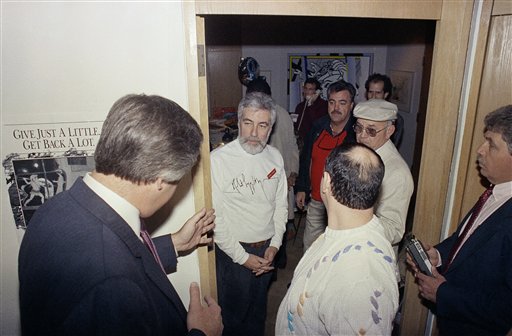Robert Mapplethorpe (1946–1989), a highly regarded if controversial photographic artist, gained notoriety for his portrayal of sexually explicit images. Although many of his works — including exquisitely lighted images of flowers — are uncontroversial, a series of homoerotic and other sexually explicit photographs made him posthumously a political target and a central figure in a First Amendment clash over the legal meaning of art and obscenity.
Mapplethorpe was born in Floral Park, New York. He was trained in art at the Pratt Institute and, after receiving a BFA in 1970, continued to work in New York City.
Mapplethorpe photos ignited controversy over federally-sponsored art
In 1990 a planned exhibit of his photographs at the Corcoran Gallery in Washington, D.C., was abruptly cancelled. Because the exhibit, including the erotic images, had been partially sponsored by federal funds, the artist, his work, and the National Endowment for the Arts were all excoriated by politicians across the country.
The controversy eventually underpinned an effort to pull back all federal funding from support of the arts and led to other offensives against alleged obscenity.
Cincinnati art center director indicted for showing Mapplethorpe photographs
A short time later, the director of a Cincinnati art museum was indicted on obscenity charges for mounting an exhibit of Mapplethorpe’s photographs that only a few weeks before had been hanging at a nearby university without incident. The photos included men displaying their genitals and engaged in sex acts.

Contemporary Arts Center director Dennis Barrie, center, stands in his office with lawyers and police officers in Cincinnati, Saturday, April 7, 1990 after being indicted on two counts of pandering obscenity over the Robert Mapplethorpe exhibit at the center. (AP Photo/AL Behrman, used with permission from The Associated Press.)
Jury said photographs did not meet definition of obscenity
In a two-week trial, the defense counsel, led by noted First Amendment attorney H. Louis Sirkin, argued successfully to a jury that the photographs did not meet the legal definition of obscenity.
The Supreme Court had said, in Miller v. California (1973), that for a work to be denied First Amendment protection it must lack “serious literary, artistic, political, or scientific value.” The jury took only two hours to acquit the director of obscenity charges.
Mapplethorpe exhibit shows First Amendment protection for art
Although the experience of the Mapplethorpe exhibit indicates the First Amendment may protect artists and their exhibitors from criminal sanctions, it also indicates that the Constitution can do little to protect them from political consequences.
This article was originally published in 2009. James L. Walker (1942-2019) taught political science at Wright State University for 33 years.

